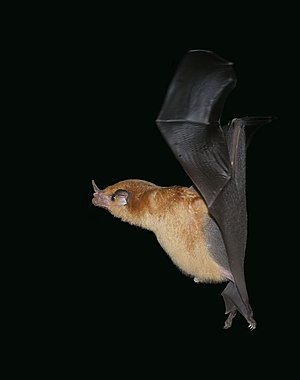Lonchophyllinae
| Lonchophyllinae | ||||||||||||
|---|---|---|---|---|---|---|---|---|---|---|---|---|

|
||||||||||||
| Systematics | ||||||||||||
|
||||||||||||
| Scientific name | ||||||||||||
| Lonchophyllinae | ||||||||||||
| Griffiths , 1982 |
The Lonchophyllinae , for which there is no German name, are a bat taxon , they form a subfamily of the leaf noses (Phyllostomidae). The subfamily is divided into five genera with twenty species.
description
The Lonchophyllinae are similar to the flower bats in physique, but differ in details of the skull and teeth. They have an elongated snout. The nasal blade is long and narrow in the genus Lonchophylla , in contrast to the short and wide nasal blade in Lionycteris . The tongue, which is provided with brush-like papillae, can be stretched out very far. The fur color of these animals varies from reddish brown to dark brown. The tail is consistently short. Lonchophyllinae reach a head trunk length of 45 to 72 millimeters and a weight of 8 to 47 grams.
Way of life
These bats live in Central and South America , their range extends from Nicaragua to southeastern Brazil . Their habitat are predominantly tropical rainforests. Like most bats, they are nocturnal, during the day they sleep in caves or hollow tree trunks. With their long tongue, they are adapted to a nectar-eating way of life, and sometimes they also eat fruits and insects.
Systematics
There are five genera with ten species:
- Hsunycteris
- The genus Lonchophylla comprises thirteen species that are distributed from Nicaragua to southeastern Brazil.
- Lionycteris spurrelli isnativefrom Panama to the Amazon basin .
- Platalina genovensium is the largest species in this group. It only occurs in Peru .
- Xeronycteris
There are different opinions about the status of this group, in some classifications the three genera are also assigned to the flower bats (Glossophaginae).
literature
- Ronald M. Nowak: Walker's Mammals of the World . P. 372, Johns Hopkins University Press, 1999 ISBN 0801857899